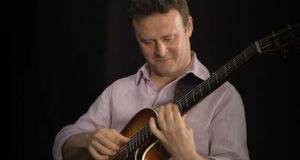Intermediate Guitar Lessons
436 videos
Reach the next level by taking this intermediate guitar course! Improve your technique and learn to play famous songs!
Intermediate Guitar Lessons
Discover part II of your guitar course. This lessons are intended for musicians who have followed Todd’s Beginner Guitar lessons, or those who already have a basic knowledge of beginner guitar concepts and want to go further.
In this intermediate Guitar course composed of more than 430 videos, you will learn to play new chords positions across the neck, execute new rhythms, scales, & arpeggios, learn to play popular songs, and more! As with the beginner course, the notions are introduced progressively, and each new concept is followed by a series of exercises and pieces to practice.
At the end of this course, you will have the ability to play popular songs with the help of backing tracks. Enjoy playing along to “Angels”, “Could you be loved”, “Creep”, “Hotel California”, and many more!
LESSON PRESENTATION
The main concepts taught
Bass and Melody
Arpeggio
Sixteenth Note
Chord Positions
Major scale and pentatonic scale
Four-note chords
Triplet and the suffle
Fret Positions
The program proposed by Todd Clouser
Take full intermediate guitar lessons!
Here is the program:
| Chapter | Notions |
Introduction |
Todd gives you an overview of what you will learn in this intermediate guitar course. |
Bass and Melody |
In this first part, Todd teaches you how to play the bass note separately from the high notes which compose the melody. You will practice on quarter and eighth note exercises before playing on backing tracks. |
Arpeggio |
In this second session, Todd shares all the techniques and tricks to master arpeggios and invites you to practice with exercises and backing tracks. |
Sixteenth Note |
Here, you will learn a new rhythmical notion: the sixteenth note. It will help you to expand your accompaniment skills. |
Fret Positions |
Now you will learn how to name and recognize the positions on the neck of the guitar. At the end of this chapter, you will know how to change positions quickly on your guitar. |
Subdividing sixteenth note patterns |
In this chapter, you will learn new rhythmic patterns: sixteenth notes followed by eighth notes and eighth followed by two sixteenth notes, dotted eighth notes. You’ll see how to switch between different rhythmic patterns while playing chords with the pick. Once again, you’ll have access to many exercises to keep practicing. |
Power chords and Palm-mute |
Learn a new type of chord: the power chord, a 2-notes chord built with the root and the fifth. You will train on several exercises to master them. After that, you will see how to palm-mute the strings and learn how to get comfortable with this technique. |
More Chord Positions |
In this session, Todd shows you more chord positions: seventh chords, add2 chords, add11 chords, suspended chords. You will apply these new chords on songs with the suitable rhythm, and see how to play them in an arpeggiated manner. |
Repertoire |
In the repertoire chapter, you will have access to a long list of songs, backing tracks to play along to, and chord diagrams to help you memorize the chords played.
|
Triplet and the suffle |
Todd addresses the rhythmical notion of triplet. Here again, you’ll have a series of exercises to train with and master this new rhythm. |
Compound measure: ternary pulse |
Here you’ll learn the difference between binary and ternary pulses and the different time signatures and compound meters that exist. Assimilate these new notions thanks to exercises and backing tracks. After that, Todd will introduce you to how the blues style works in guitar, what is the structure of blues, and which are the main blues chords. |
Major scale and pentatonic scale |
Learn more about the major and pentatonic scales. In this session, Todd explains how these scales are built and what are their characteristics. You will learn to play scales on different positions along the neck of the guitar. You will also work on your fingering technique. |
Four-note chords |
In this last chapter, Todd teaches you how to build chords with a root note, a third and a fifth! You will be able to see the anatomy of major and minor triads. You will also see seventh chords, blues chords and half-diminished chords. Many songs and backing tracks are including so that you can easily practice and improve. |
Congratulations |
Todd congratulates you for how far you’ve come. He leaves you with a series of famous songs to play along to, such as:
|




